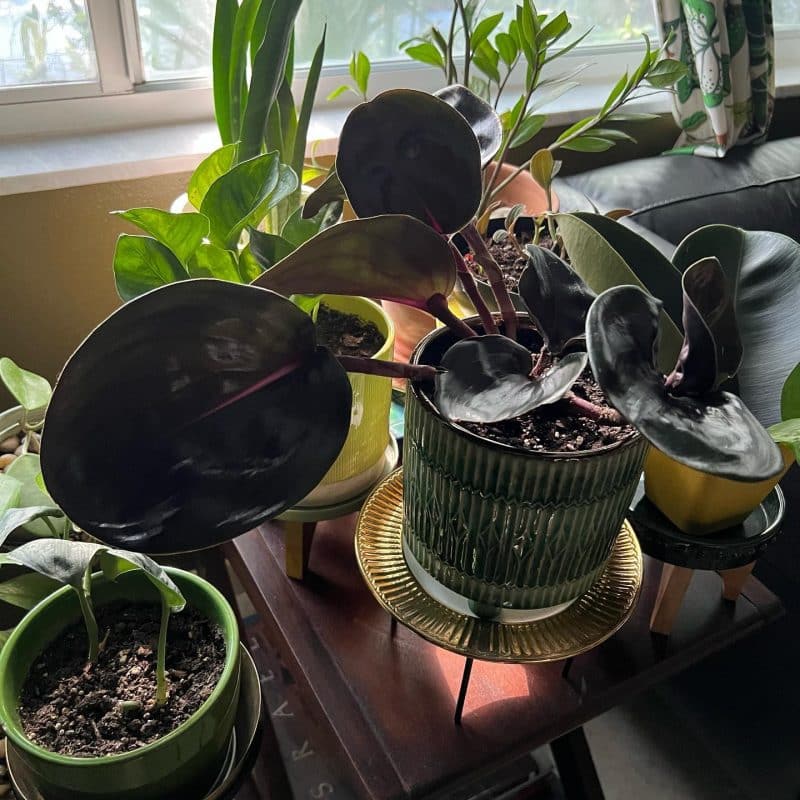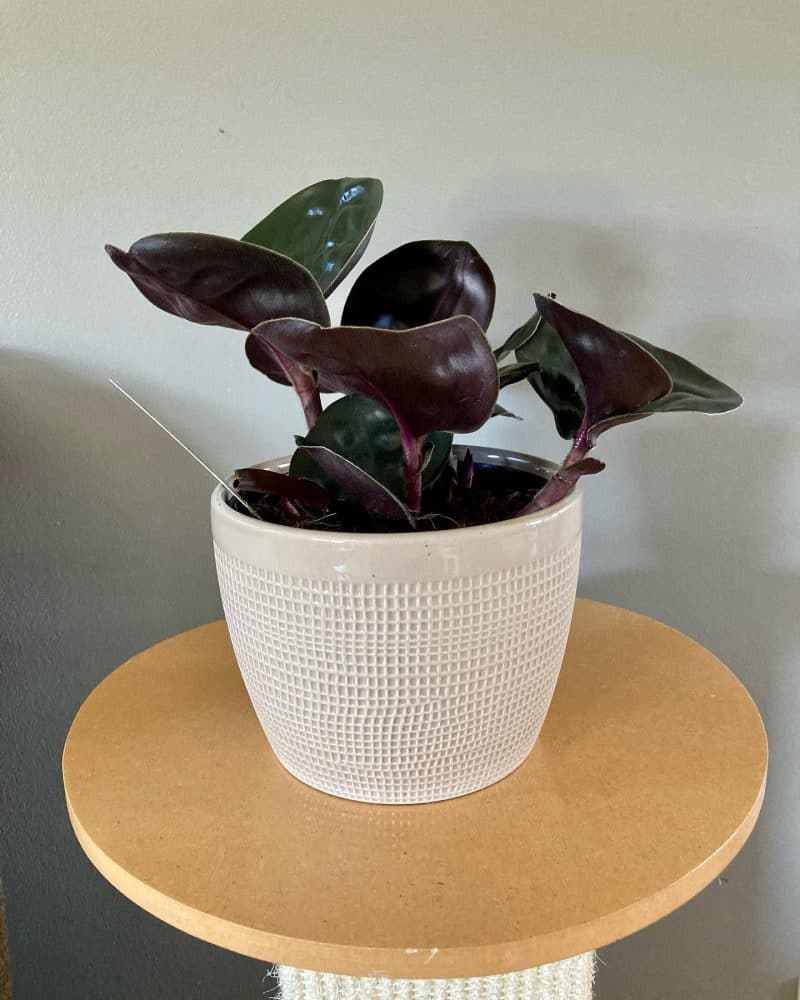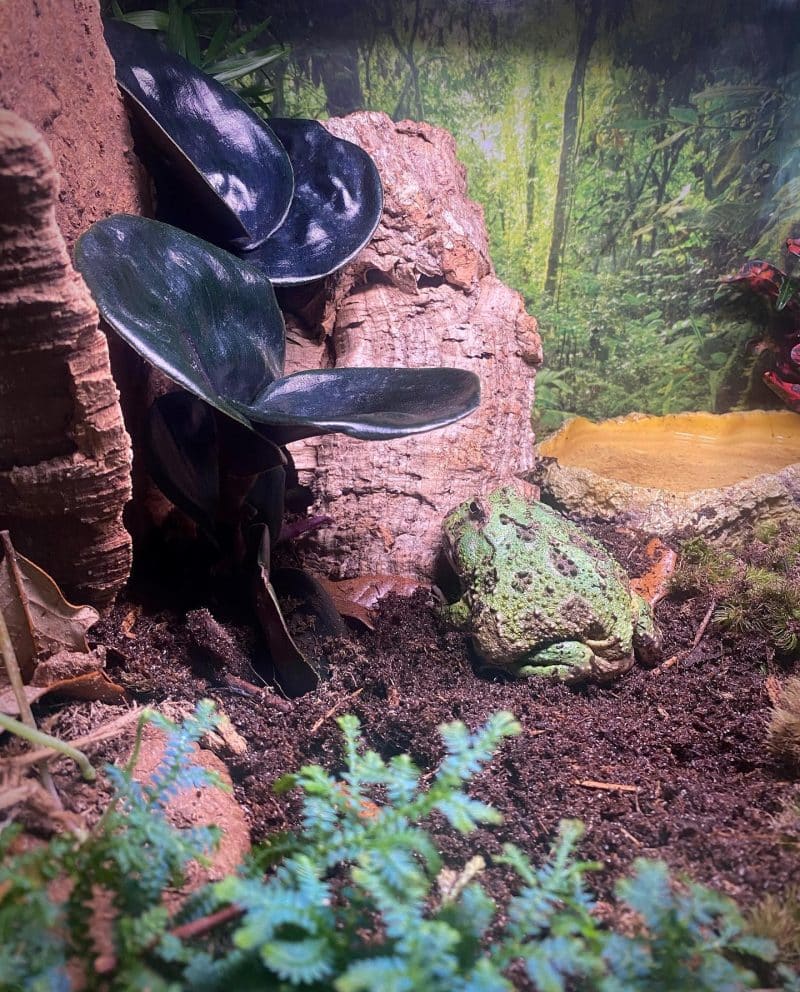Geogenanthus Ciliatus, the “Geo plant” for short, is a plant lover’s dream—including mine! With its striking, lustrous green and purple leaves, there’s no indoor plant I own that causes more people to ask, “What is that?
Geogenanthus Ciliatus is a stunning, once-rare plant from the South American rain forest that has now come into the mainstream. This species is best grown in a humid environment like a terrarium, but fear not: I can teach you the proper plant care basics so that your geo plant will easily thrive in almost any climate.
In this article I’ll cover Geogenanthus Ciliatus plant care tips, how propagate with stem cuttings for your friends, and what to do if you start noticing brown or pale leaves.
Table of Contents
Geogenanthus Ciliatus Care Guide

History, habitat, and characteristics
Before we cover plant care for the Geo Ciliatus plant, a quick tour of its origins and how it made its way from the tropics to indoor gardens worldwide.
Geogenanthus Ciliatus is native to the South American tropical rainforests of Peru, Colombia, and Ecuador. Before its recent introduction at local gardening centers, this rare species was only available to serious collectors.
The Geogenanthus Ciliatus is a true rarity—an entirely new indoor plant genus! (Geogenanthus is the genus, while ciliatus is the species). The plant has two other species, poeppigii and rhizanthus, but only the poeppigii is suitable for an indoor houseplant.
It’s such a head turner that it won the coveted “Best New Foliage” award at the 2022 Tropical Plant International Expo.
Geogenanthus Ciliatus has a striking appearance that changes as the plant grows. At first, you’ll notice a luscious bright green divided by a purple stripe.
As it grows and thrives, you’ll notice shiny dark purple leaves that appear almost black. If your plant is happy, it may even produce small odorless purple flowers.
While Geogenanthus Ciliatus appears to be a succulent, its waxy leaves can be deceiving. Geo plants are actually a member of the spiderwort (Commelinaceae) family, related to teddy bear vine (Cyanotis), oyster plant (Rhoeo), and inch plants (Tradescantia).
Geo plant leaves can grow to be over eight inches long and the plant itself can stretch to over 24 inches wide.
Now let’s cover plant care for the Geogenanthus Ciliatus.
Light

Geo plants cannot tolerate direct sunlight. As a groundcover rainforest plant, they’re used to low light conditions under the shade of higher plants and trees.
Partial or indirect natural light is the way to go with this beautiful houseplant to avoid severe sunburn.
While your geo plant can’t be placed in direct sunlight, that doesn’t mean it can survive in the darkness. To develop its full rich color, it needs low to medium sunlight at a safe distance.
So, what’s a safe distance? Try to place it less than three feet from a window. If you can’t, make sure the window has some diffusion material over it (curtains, frosted glass, window clings).
If you have an environment that doesn’t receive enough light, consider incandescent or LED artificial lights to help your Geogenanthus Ciliatus thrive. Place them about 20 inches directly above the plant for best results.
We’ll go more into ideal humidity later, but since it is a rainforest plant, you can also consider keeping your Geogenanthus Ciliatus in a terrarium with fluorescent lights. This way, you can easily control the light, temperature, and humidity levels.
Water
Geogenanthus Ciliatus is a thirsty plant. Its waxy leaves retain moisture, but don’t like to be drenched. When watering, make sure to pour around the plant to protect from fungus growth.
How often you water your geo plant will depend on the shade and humidity in its environment. A good test: stick a finger into the first 2-3 inches of soil. If it’s dry to the touch, it’s time for watering. You shouldn’t have to water more than two times a week, but in a humid environment, watering could be less often.
I default to using distilled water because I have other plants that need it, and I know my water runs a bit soft, but you can try tap water first. Also, as a general rule of thumb, this plant prefers to be overwatered rather than underwatered.
What to look out for:
If you see your Geogenanthus Ciliatus wilting, that’s a clear sign to increase the frequency of watering. While its drooping leaves may look dramatic, don’t despair! Your geo plant will perk right back up into its proud hydrated self almost immediately after you water it.
Temperature and Humidity

Geogenanthus Ciliatus flourishes in temperatures between 50 and 75 degrees Fahrenheit.
Outdoors, it loves warm climates and thrives in the temperature of USDA growing zones 11/12.
A word of warning: even brief exposure to cold air, such as while you’re moving the plant from a store to your home in winter months, can shock and damage Geogenanthus Ciliatus leaves. You’ll want to keep it covered during any time it may be in a colder temperature.
Its preference for warm climates also means Geogenanthus Ciliatus loves humidity—the more, the better. Unlike you, your geo plant prefers between 60% to 90% humidity during the day and 70% to 90% at night.
For many, this number probably seems daunting, and you may find it easier to maintain the high humidity levels geogenanthus plants prefer in a terrarium or a bathroom.
Other options are: frequently misting, placing it near a humidifier or evaporation tray, or bringing it outdoors if you have humid summers.
Soil and Planting
Geogenanthus Ciliatus needs well-draining soil, which for an indoor plant means a pot with a large enough drainage hole. Beyond that, you’ll also want soil that’s slightly acidic, or at a level slightly below a pH of 7.
The ideal soil mix for a Geogenanthus plant is:
- 75% general house plant potting mix
- 25% orchid bark, peat moss, or perlite
This combination ensures good drainage and acidity, isn’t hard to find, and will provide all the nutrients necessary.
Do you need to fertilize your Geogenanthus Ciliatus? Yes, but only during the spring and summer months when it’s actively growing. Any organic liquid fertilizer will have the correct nutrients, but make sure that it is 50% diluted to avoid disturbing the soil pH. Undiluted fertilizer is too strong for this plant and may burn the leaves.
The fertilizer you choose should have a 10-10-10 ratio. This means it has equal parts total nitrogen, phosphate, and potash, the Big 3 nutrients.
To create the right growth conditions, you’ll need to repot your Geogenanthus Ciliatus plant with fresh soil to replenish its nutrients. Either wait until it grows to twice its original size or after one year, whichever comes first, before looking at new pots.
Now that we’ve covered the plant care guide, let’s talk about propagation.
Propagation Guide
The best time to propagate Geogenanthus Ciliatus is in spring at the start of the growing season and there are three methods available: stem cutting propagation, jar of water propagation, and rhizome division propagation.
If you don’t have a lot of experience propagating plants, I’d recommend stem cutting first.
Stem cutting propagation:
- Select a healthy Geogenanthus Ciliatus stem bearing one or two leaves.
- Use pruning shears to cut the stem right below the leaf.
- Set it down to dry in a safe place for several hours.
- Next, dip its end/node in rooting hormone.
- Dig a hole an inch or two long with your finger in a small pot filled with fresh soil.
- Ensure that your Geogenanthus Ciliatus is straight up as you place it in the holes and carefully pack soil around them.
- If you find that your new stem cutting is drooping, you can use a small wooden stick to support it. Pencils, pens, or popsicle sticks in the summer all work.
- Water the soil and ensure it remains moist while your new geo plant starts to grow!
Jar of water propagation:
- Follow steps one and two above.
- Fill a small tube or glass with water.
- Place the Geogenanthus Ciliatus plant cutting in the container.
- Patiently watch as a root network forms.
- When roots are at least several inches long, follow steps five through eight above.
Rhizome division propagation:
- Remove your Geogenanthus Ciliatus carefully from its pot.
(One optional trick to make this easier is to water the soil your geo plant is in a day before you plan to propagate it. This way, it will be softer and more yielding with less chance of root damage upon extraction.) - Gently brush the soil off of your geo plant’s roots. Feel free to use a light pressure water stream from your kitchen sink or a hose for particularly stubborn bits.
- Use shears to split the Geogenanthus Ciliatus by its rhizomes. Rhizomes are the larger stem-like parts that roots grow from, previously under the soil you just removed. The larger your plant is, the more rhizomes/sections it will have.
- Transfer each section into its own pot filled with the appropriate soil mixture.
Common Issues
Here I’ll cover the most common issues for caring for a Geogenanthus Ciliatus. When growing a plant for the first time, it’s not at all unusual (they are called common issues, after all!) to have a few problems come up, but thankfully each one gives us a clue about what the cause might be.
Some of these will be unique to the geo plant, but others are symptoms you’ll see in any plant having difficulties like:
- Curling leaves. If the leaves are limp or curling up at the edges, your Geogenanthus Ciliatus is probably too dry. Similarly, if it starts to brown and crisp, that’s your geo plant’s way of telling you it needs more water and humidity.
- Muted color. Your geo plant’s color can also become muted if the leaves gather too much dust, as the chlorophyll is blocked from the sun. Gently wipe down the leaves with a damp cloth and you should see improvement in just a few days.
Why does it have brown spots on leaves?
The Geogenanthus Ciliatus is very sensitive to cold. Even a minute or two of wintry air can cause leaf crisping and browning, and this plant is far too pretty to suffer such a fate!
Your Geogenanthus plant will also burn and become less vivid under direct sunlight. If you see your geo plant browning or crisping and it hasn’t been in cold temperatures lately, this is the most likely cause.
Finally, brown spots on leaves can be a result of root rot, which I cover more in the diseases and pests section below.
Diseases and Pests
Insects
Spider mites, mealybugs, and aphids all like to feed on plants. If you see your Geogenanthus Ciliatus leaves turning yellow, it may be because these pesky pests are munching on your plant.
Given enough time, your leaves may start to look more like potato chips—brown and crispy. If the number of insects feeding is large enough, the geo plant’s leaves may even start falling off.
To address an insect infestation, I prefer to use soap, alcohol, or neem oil. Options include:
- Mix disinfecting alcohol with 80% water and spray it on any visible pests.
- Use soap and water to wash insects out from under the stem and leaves of your plant. If you can get your hands on an insecticidal soap, that will be useful to kill larvae as well.
- Apply neem oil with a Q-tip to any problem leaves until the problem resolves.
I prefer to avoid insecticides, as these can stunt the growth of a plant and are usually overkill.
Root rot
Does your Geogenanthus Ciliatus have brown-colored spots on its leaves? This is the most common sign of root rot.
Although the geo plant needs to be moist, it doesn’t like to be constantly drenched. Plants like water, but root rot loves overwatering.
To treat it, carefully remove your geo plant from its container and examine its roots. Those affected will be black and squishy to the touch. These cannot be saved and must be cut away from the plant with sharp, sanitized shears.
You can save any other roots, even black but firm ones. Gently wash these off and plant them in a fresh pot with a new soil mix. Ensure that the pot’s drainage hole is large enough and that the soil remains moist but not oversaturated.
Conclusion
The Geogenanthus Ciliatus is fast making its way from a rare Amazonian jungle plant to a staple of indoor gardens. Its unusual dark green and purple hues and color-changing maturation make it a plant to watch in all seasons.
Despite what you may have heard, plant care for this indoor species isn’t difficult. Remember: make sure Geogenanthus Ciliatus stays out of direct sunlight, but in a dark room, boost it with artificial lights for best results. Propagate it through stem cuttings, water, or rhizome division.
With a healthy dose of humidity, low light, and moist water conditions, the Geogenanthus Ciliatus plant will be the shining star of your collection for years to come.
Did we mention it filters the air, too? A nice bonus!
FAQ
Is Geogenanthus Ciliatus a rare plant?
Geogenanthus Ciliatus used to be a rare plant found only on the Amazonian jungle floor, but now it’s become one of the most desirable houseplants in the plant lover’s arsenal.
Where can I buy a Geogenanthus Ciliatus?
While Geogenanthus Ciliatus used to be almost impossible to find, now this species has become so coveted that it’s available at most big box stores with gardening sections—that is, if it hasn’t sold out already!


